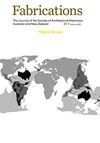Three Ideas of Emptiness: Structural Biases Towards Isolation, Separation and Absence in the 1979 Australian Parliament House Competition Brief
IF 0.3
0 ARCHITECTURE
Fabrications-The Journal of the Society of Architectural Historians Australia and New Zealand
Pub Date : 2022-09-02
DOI:10.1080/10331867.2023.2190686
引用次数: 0
Abstract
ABSTRACT The 1979 competition brief for Australia’s Parliament House has been described as an exceedingly complex, bureaucratic document. Its 170 pages summarise site and user data in tremendous detail. Yet, curiously offer little information about Australia’s democratic values and guiding principles. The absence of this information is significant as it inhibits discourse on architecture's capacity to enact the democratic practices of the Australian people in built form. This essay compares the 1979 brief to the parliamentary reports from which it was developed. Through amending, rephrasing and reframing earlier content, the brief is shown to introduce three structural biases: towards the isolation of site, the separation of interior activities and the absence of emphasis on democratic values. These biases established real and significant pressures for competition entrants on how to conceptualise and design Australia’s most significant, most anticipated, architectural emblem of its democratic identity. In this historical instance, this essay argues, what preceded the representation of power in Australia’s parliamentary architecture were moves to evade the representation of Australian democracy in the brief, which exacerbated a different type of power: the power over what to include and exclude.空虚的三种观念:1979年澳大利亚国会大厦竞赛简报中对孤立、分离和缺席的结构性偏见
摘要1979年澳大利亚国会大厦的竞赛简报被描述为一份极其复杂的官僚文件。它的170页对网站和用户数据进行了极其详细的总结。然而,奇怪的是,关于澳大利亚民主价值观和指导原则的信息很少。这些信息的缺失意义重大,因为它阻碍了关于建筑以建筑形式体现澳大利亚人民民主实践的能力的讨论。本文将1979年的简报与制定该简报的议会报告进行了比较。通过对早期内容的修改、改写和重构,该简报引入了三种结构性偏见:对场地的隔离、内部活动的分离和对民主价值观的不重视。这些偏见为参赛者在如何构思和设计澳大利亚最重要、最受期待的民主身份建筑标志方面带来了真实而重大的压力。在这个历史例子中,本文认为,在澳大利亚议会结构中权力代表性之前,是为了在简报中回避澳大利亚民主的代表性,这加剧了一种不同类型的权力:包括和排除什么的权力。
本文章由计算机程序翻译,如有差异,请以英文原文为准。
求助全文
约1分钟内获得全文
求助全文
来源期刊

CiteScore
0.50
自引率
25.00%
发文量
26
 求助内容:
求助内容: 应助结果提醒方式:
应助结果提醒方式:


